In Part One we looked at the simpler aberrations – diffraction, vignetting, depth of field, focal length perspective, tilting, shifting, and bokeh. These are ‘macro’ aberrations, easy for the eye to see and study.
In this part we’ll look at those aberrations that are hard to study, either because they are too small or because they only occur under certain conditions. You’ll have to dig hard to uncover these, but I feel it’s better to suffer at the beginning than find out when it’s too late. Some of these aberrations are too expensive to fix once recorded.
Let’s continue our car wash. We’re getting into the harder-to-reach places now.
Spherical Aberration
This is potentially the most serious aberration in a lens, because it has everything to do with the lens design itself. If you have noticeable spherical aberrations, there is almost no option but to replace your lens.
Remember the Airy disk in Part One? The effects of spherical aberration are similar to what happens due to diffraction. It turns what should be a point (dot) into mush:

Why does this happen? It usually happens because the lens is curved, or spherical. Rays have to converge at one single point for sharp focus. When the rays coming from outer edges of the lens don’t hit the right spot, you get the above result. It happens to all spherical lenses.
When you have a spherical aberration problem, there’s nothing you can do about it, except look for a different lens. How do you know your lens has this disease? If your images look blurry, and you have eliminated all the other reasons why it should be so, then whatever remains dictates you have to return your lens.
Chromatic Aberration
Chromatic aberration is possibly the ugliest looking aberration, because it looks like a toddler has used crayon to outline the sharp edges in your image. The frustrating part is, it only shows up under certain conditions, and the only hope of fixing it is in post production.
Chromatic aberration usually manifests itself as colors around hard edges:
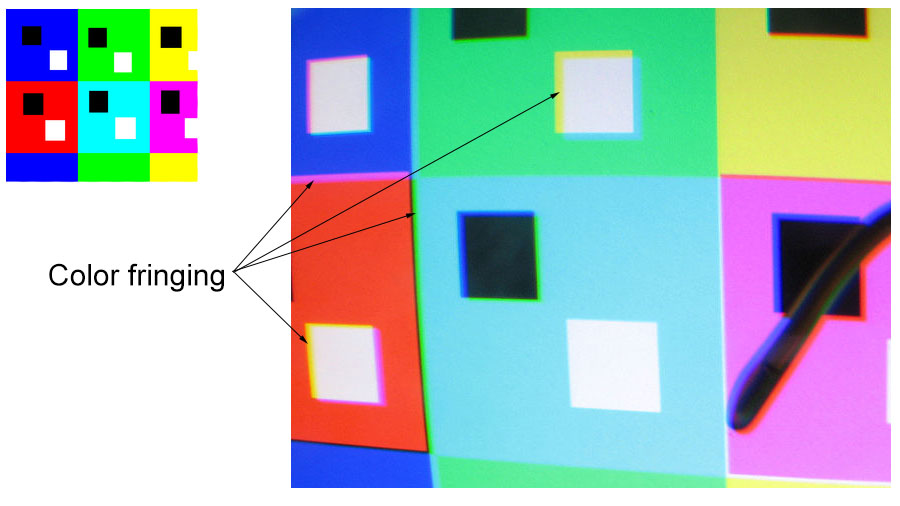
Just because we notice color fringing around the edges doesn’t mean the other parts aren’t affected. If colors shift across the board, then the color rendition of the lens will differ from the scene. All lenses change colors to a certain extent.
There are certain types of fringing, like purple fringing, that are not always caused due to chromatic aberrations. Modern-day bayer sensors have issues that bring in artifacts of their own. The only surefire way to know who the culprit is (lens or sensor) is to test them with other lenses or sensors.
Ever seen how a prism splits white light into different colors? Something similar takes place here – different wavelengths of light (colors) disperse through different mediums (glass of the lens) – at different angles (which is why you only see chromatic aberration at certain angles). If you do see chromatic aberrations across the board, change the lens. However, before you do, know that kit lenses, and other cheap lenses, usually show chromatic aberration as the norm. Some expensive lenses do too.
Wait a minute. Why would anyone buy an expensive lens if it shows chromatic aberration? That’s where your experience comes in. Every lens is a trade-off. Cheap kit lenses are cheap, but suffer optically. Expensive lenses have their strengths and weaknesses too, and manufacturers assume a professional with years of experience might have sufficient wisdom to know when to use what.
Or maybe they just feel they can get away with it.
When in doubt, study the corners of a lens and compare it with the center regions. Usually, the corners have the worst aberrations. An average lens that costs anything should have strong center performance. The most expensive lenses try to have good ‘equal’ performance on all four corners. If neither of the last two statements holds true, then lose the lens.
Coma
Think spherical aberration-like, but instead of all the blobs having the same center, they align single file:
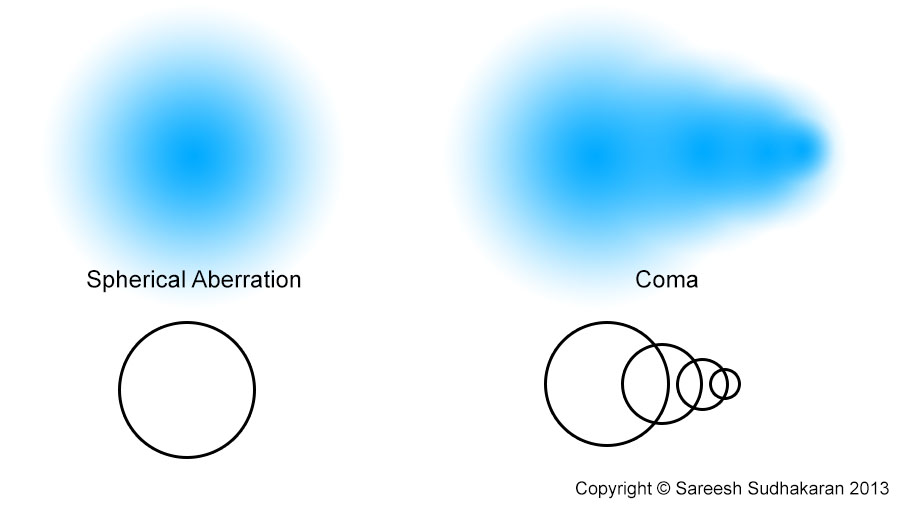 Just because coma looks like spherical aberration it doesn’t mean they are caused the same way. Coma is caused due to differences in magnification (one ray increases the dot while another might reduce it while a third might keep it the same size, etc.). The reason why they arrive at different points along a line is because coma is usually caused by off-axis light (coming from the side). Each ray takes a different path along the axis of the light and arrives at its place in the comet-like shape.
Just because coma looks like spherical aberration it doesn’t mean they are caused the same way. Coma is caused due to differences in magnification (one ray increases the dot while another might reduce it while a third might keep it the same size, etc.). The reason why they arrive at different points along a line is because coma is usually caused by off-axis light (coming from the side). Each ray takes a different path along the axis of the light and arrives at its place in the comet-like shape.
You can use a magnifying glass against the sun to see coma, just tilt the glass so the sun’s rays come in at a weird angle. Coma shouldn’t be very bothersome. One way to reduce off-axis light is to stop down the lens. Another, is to move yourself a bit. Coma, when it happens, should be confined to the outer edges of your lens, and never in the center.
Any coma that is always present signals its time for your lens to be lovingly handed back to the manufacturer or reseller, in the packaging it arrived in.
Astigmatism
Don’t let the name scare you. When we think of lenses, we think ‘perfectly circular’. But lenses don’t have to be perfectly circular. Most aspect ratios are horizontal, so it makes sense if a lens designer pays more attention to the horizontal and wider region than the vertical and narrow region. Anamorphic lenses are another example.
So, instead of a purely circular lens, you might have one that is slightly oval:
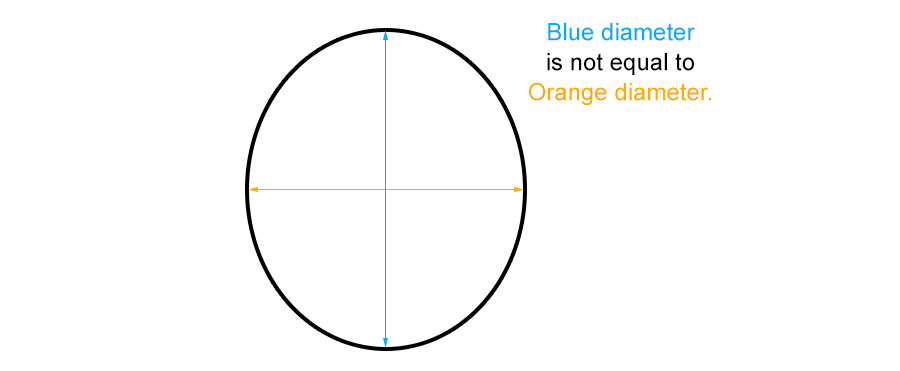
Now, imagine rays coming in parallel to the blue line, being affected by spherical aberration. The same rays, when coming through the orange line, might not be affected by spherical aberration because of the design. When this happens, you have the following strange situation:
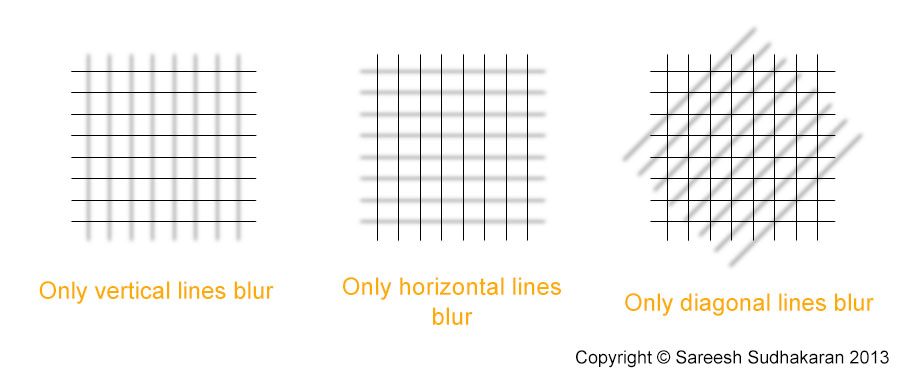
You might often hear about people complaining about lack of sharpness or resolution along a particular line. The culprit is astigmatism. It’s another form of spherical aberration, just happening selectively. Its effects are usually seen at the outer regions – the further you are from the center of the lens the more the astigmatism.
Astigmatism can also be caused by mis-aligned lens elements, but no matter what the cause, if the effect is severe or in the center of the frame regularly, it’s time to find a new lens.
Field Curvature
Field curvature is unintended Scheimpflug principle. Instead of having a vertical wall of the plane of focus, the wall is now curved:

Every lens has some form of field curvature, due to its spherical nature. You know field curvature from other aberrations when the blurriness (it shouldn’t be that bad!) or lack of sharpness appears an all sides, as if the plane has been curved. It might only happen along one axis, or like astigmatism it might effect each axes differently. In simple terms, it’s vignetting without the blackness.
There are very few lenses (especially wide angle lenses) on earth that don’t exhibit some form of noticeable field curvature. Shoot a newspaper and watch the edges. You can’t do much about it, except resign yourself to it or find a sharper lens. Lenses corrected for all the aberrations are the most expensive ones.
Resolution, Acutance and Sharpness
Now that we have seen all the aberrations, we can understand why different lenses have differing degrees of sharpness or resolution. To understand these terms in depth, please read the following articles first:
To keep it short:
- Resolution is the smallest detail a lens can render. The greater the detail the greater the resolving power of a lens.
- Sharpness is directly related to human visual acuity. It’s a perception that is caused by many factors.
- Acutance is the contrast in the edges of objects in an image. It is also called edge contrast, and is one of the reasons why we perceive an image to be less or more sharp than another, provided the resolution is the same.
Now we come to the point where everything you know about aberrations is turned upside down:
- Due to field curvature, if the borders of an image are blurred, the effect is somewhat similar to a blurred out of focus background. This draws the eye towards the center portion. The same can happen with vignetting.
- Chromatic aberration might increase the perception of sharpness because it will increase perceived acutance.
- If we align lines correctly, astigmatism may be used to bring out lines or objects in a certain axes while diminishing the resolution of the rest.
- Spherical aberration can eliminate moire.
This is why it is not always proper to talk about aberrations as defects. If a lens is advertised wrongly, that’s another matter. Lenses created for scientific, medical and military applications have to work as advertised. Lenses created for filmmaking and photography have aesthetics as the primary goal, not scientific or technical accuracy.
Even if we have a perfect lens, free of all aberrations, there is no guarantee all cinematographers, photographers and viewers will prefer the resulting imagery over an imperfect lens. This is why, rather than complain about minor imperfections, it is more productive to understand it as lens character and use that to your advantage.
Let’s look at three more aberrations that deliver loads of character.
Barrel Distortion
Distortion happens when the entire image is affected as a whole. The first notable kind of distortion is barrel distortion:
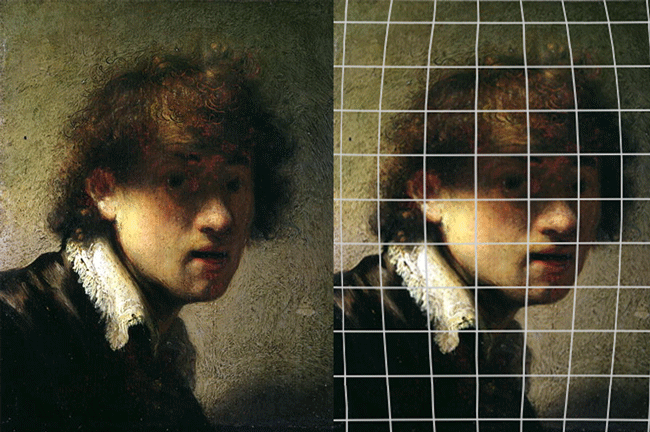
Barrel distortion is most prominent with wide angles.
Pincushion Distortion
The second image in the animation (the one that sucks his face in) is pincushion distortion. This kind of distortion is most prominent with telephoto lenses.
As you can imagine, these distortions can be used to make someone look fatter or thinner than they really are. There is a third kind of distortion, which is a combination of barrel and pincushion distortion. This is called the Mustache distortion:
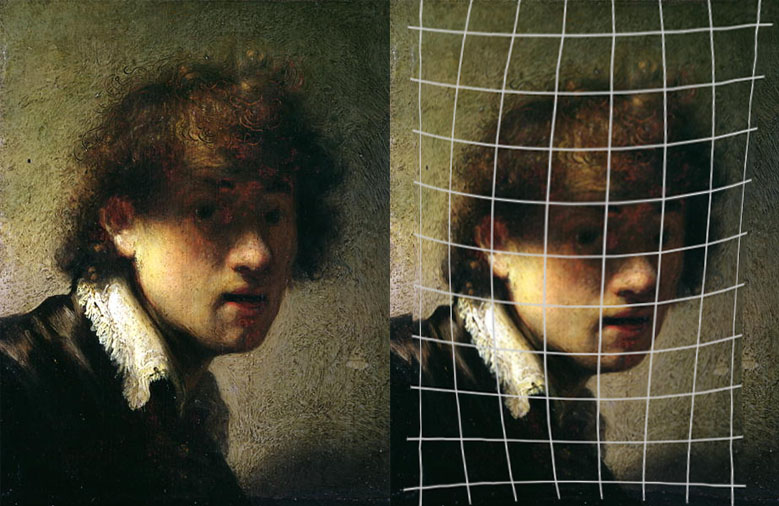
I just played with the image in photoshop. In a true mustache distortion, the center portion will stick out like a wart, which some people believe enhances the 3D effect.
To test for distortions, shoot graph paper or a brick wall at different focal lengths and apertures.
Flare and Ghosting
Ideally, one would want the light to pass through a lens directly onto the sensor, without bouncing around anywhere. To this end, the interiors of lenses and sensors are painted jet black. The lens mount is designed to be a twist-lock (screw or bayonet) system so that it is not the weak link in this chain. Yet, there is one weak link in this system, and that is the front of the lens.
Light falls into the lens from the scene you are aiming at, but it also spills in from the sides. In general, this effect is called Flare.

Flare always happens. Sometimes it manifests itself as solar or lens flare, a bright spot of light with circular bands, and is easy to see. Mostly, though, it is not very obvious, and the effect reduces the contrast of an image.
Ghosting is thought of as a kind of flare, but is really the reflection of something that is projected on to an element in the lens:

If you have bright sources of light shining straight into the lens, like light bulbs, etc., you might see ‘ghosts’ of it in other parts of the frame. Hence the name ‘ghosting’.
Since we are so used to seeing flare (even in our eyes), the effect seems natural when used with restraint. Some effects of flare, like anamorphic lens flare, are coveted as if they are brush strokes from Picasso himself.

Whatever floats your boat! Now you know that you can use aberrations just as creatively as you can use anything else related to filmmaking.
At the beginning I said only two questions were relevant:
- What aberrations are the most pronounced, and
- Will it affect our style of shooting?
Now you know what to look out for in a camera lens, what the aberrations are called, and how to test for them. The answer to the second question is entirely up to you.
Ultimately, let me repeat that photography and cinematography camera lenses are tools whose primary function is one of aesthetics, not technical accuracy. If you like the look of a lens, that’s all that matters. If you can become that confident, you won’t have to do another lens test in your life!